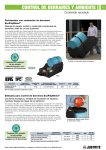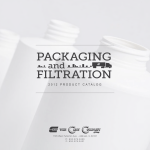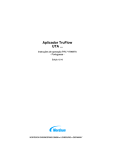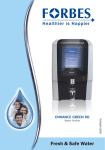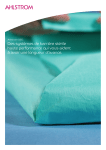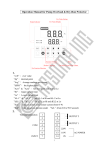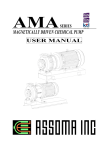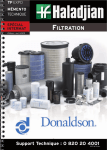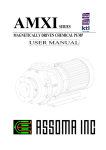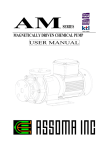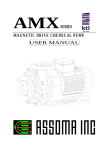Download CARTRIDGE/BAG FILTER
Transcript
AMF⁄AMF-B SERIES CARTRIDGE/BAG FILTER-PUMP USER MANUAL Table of Contents 1. Foreword ........................................................................... 1 2. Installation and Piping ....................................................... 1 3. Priming Instructions and Notes ......................................... 2 4. Inspections and Maintenance ............................................ 3 5. Troubleshooting................................................................. 5 Appendix A: Exploded View and Parts List of AMF ............. 6 Appendix B: Exploded View and Parts List of AMF-B ......... 7 AMF SERIES 1. Foreword Thank you for purchasing an AMF Series filter-pump. To ensure proper operation and maximum efficiency, please read this instruction manual carefully. Failure to follow the recommended operating conditions outlined in this manual may result in serious personal injuries and/or equipment damage. 2. Installation and Piping 2.1 Pre-Installation Inspection (1) Check the filter-pump exterior for any physical damage that may have been incurred during shipping. (2) Use a small screwdriver to rotate the impeller of the motor’s cooling fan. The fan should turn easily. If the fan feels tight or if there are unusual sounds, the interior of the pump may have been damaged during shipping. (3) If there is any damage to the pump, contact the shipping company and the distributor immediately to determine who should pay for the damage, and to arrange for replacement parts. (4) The filter and pump each has a nameplate, indicating the model, MFG number, rated head, flow rate, and motor power, voltage, frequency etc. Check these data to ensure they comply with your order and application. 2.2 Installation (1) The filter-pump system should be installed on a leveled surface, with the weight of the filter-pump evenly distributed. (2) The AMF filter-pump is coupled with a rear pullout pump. The pressure gauge and priming cup are located on the motor end of the system. Therefore, please take into consideration the ease of operation and maintenance when installing the filter-pump. (3) Do not disassemble the filter chamber from the base plate. If modification to the filter is required, please contact ASSOMA INC. or authorized agent in your region. The tightening torques of the cover fastener and position stud: Model Cover fastener Position stud AMF-12/24/36/54/B01/B02/B06 125±5 kgf‧cm 160±10 kgf‧cm 2.3 Suction/Discharge Piping (1) For best performance, minimize the suction head by using straight, short piping. Suction and discharge piping should be properly supported. The pump should not be used as a means of providing support to the piping. When designing supports, consider the effects of temperature changes on the supports to avoid thermal stress. (2) The piping system should not have upward bumps that may collect air. The inlet piping should also have a 0.01~0.02 slope increase towards the pump. 1 AMF SERIES (3) Suction piping should be airtight. If air is allowed to seep into the suction piping and into the pump, the pump might be damaged. (4) There should not be any elbows for at least 5 times the pipe diameter from the opening of the pump. (5) The filter-pump system is not designed to bear the weight of the discharge piping. Therefore, please ensure the necessary piping support is in place. 2.4 AMF Filter-Pump Specification Capacity * Model Cartridges / Bag ( l/hr) Power ** ( kW ) Inlet x Outlet *** ( mm ) Max. Temp ( oC ) Max. Pressure ( kg/cm2 ) AMF-1 10" x 1 450~900 0.065 15 x 15 70 0.8 AMF-2 20" x 1 600~1,200 0.065 15 x 15 70 0.8 AMF-4 20" x 2 1,800~3,600 0.18 25 x 25 70 1.5 AMF-6 20" x 3 2,700~5,400 0.25 25 x 25 70 1.5 AMF-12 20" x 6 5,000~10,000 0.4 40 x 40 70 2 AMF-16 20" x 8 6,000~12,000 0.75 40 x 40 70 3 AMF-24 20" x 12 9,600~19,200 1.5 50 x 50 70 4 AMF-36 20" x 18 12,000~24,000 2.2 50 x 50 70 4 AMF-54 30" x 18 16,000~32,400 3.75 65 x 50 70 4 AMF-B01 #01 x 1 5,000~12,000 0.4~0.75 40 x 40 70 4 AMF-B02 #02 x 1 9,600~36,000 1.5~3.75 50 x 50 70 4 AMF-B04 #04 x 1 1,800~5,400 0.18~0.25 25 x 25 70 1.5 AMF-B06 #06 x 1 5,000~12,000 0.4~0.75 40 x 40 70 4 Note: * The listed filtration capacity shown above is for reference only. The actual capacity will be depending on the liquid property, the type of cartridge/bag and the resistance of the piping system. ** In accordance with the required capacity of filtration, various models of the pump can be selected to conform to the requirement. *** Inlet and outlet dimensions can be changed to match customer’s requirement. 3. Priming Instructions and Notes 3.1 Priming Procedure Action Valve Status Suction Priming Breeder Discharge 1. Inspect piping to ensure they are properly connected and the top and bottom covers are secured. Open 2 Close Close Close Drain Close AMF SERIES Action Valve Status Suction Priming Breeder Discharge Drain 2. Use a small screwdriver to check the cooling fan of the motor. 3. Ensure all suction valves are opened. 4. Open the priming valve and open the breeder valve by 1/3. Perform priming by pouring the liquid into the priming cup. Continue until liquid level stays constant. Open Open Open 1/3 Close Close 5. After priming, shut off the priming valve and start the pump. (Be sure to check the direction of rotation of motor.) Keep breeder valve open till priming is complete. Open Close Open 1/3 Close Close Close Open till desired flow rate Close 6. Slowly open the discharge valve till the desired pressure or flow rate is achieved. Open Close 3.2 Notes in Operation (1) The heart of the filter-pump system is the seal-less pump, which should be protected from “Dry-Running”. (2) If there is a power failure during operation, make sure to shut off the power to the filter-pump system. (3) During priming, keep the breeder valve open 1/3 to prevent the liquid from spraying out too fast. 4. Inspections and Maintenance 4.1 Daily Inspection Visual Inspection 1. Check the filter for corrosion and oxidation. 2. Check the pump, filter and piping for leaks Operation Status 1. Check for abnormal vibration and noise. 2. Check tank liquid level, pressure gauge and flow meter. 4.2 Changing the Filter Cartridges (1) The timing for changing the filter cartridges can be determined from the flow rate. The cartridges should be changed if the discharge valve is fully opened and the desired flow rate still cannot be reached. 3 AMF SERIES (2) If the flow rate is not an important factor, then the filter cartridges should be changed based on the pressure drop according to the following table. Model AMF-1/2 AMF-4/6 AMF-12 AMF-16 AMF-24 AMF-36/54 AMF-B01/02/06 AMF-B04 Pressure Drop (kg/cm2) 0.4 0.8 1 1.2 1.8 2 1.5 0.8 Note: (1) Pressure Drop (kg/cm2) = Filter Gauge Pressure – Discharge Pressure = Filter Pressure Gauge – S.G. x Discharge Head (m)/10 (2) Above table shows maximum suggested pressure difference for changing the filter cartridges. If pressure difference is above suggested value, the flow rate will be very small, with diminished filtration effect. Furthermore, the service life of the pump may also be affected. The flow rate must not be lower than the minimum recommended flow rate for the pump used. (3) The above suggested pressure difference is for PP material Meltblown type filter cartridges, with a viscosity of 1 cp. 4.3 Procedure for Changing Filter Cartridges Action Valve Status Suction Priming Breeder Discharge Drain Close Close Open 1/3 Close Open Open Close Close Close Close 1. Shut off power 2. Open breeder valve and drain valve and drain the liquid from the filter chamber. 3. Loosen the swivel stud and remove the top cover. 4. Loosen the cartridge fasteners and remove the used cartridges. 5. Rinse the interior of the filter chamber. 6. Put in the new cartridges and secure the fasteners. 7. Replace the top cover and fasten the swivel studs. 8. Rinse the filter exterior to remove excessive chemicals from the metallic parts. Take special care not to wet the electrical parts. Note: During draining, the discharge valve should be closed to prevent siphoning effect. 4 AMF SERIES 5. Troubleshooting Failure Possible Reasons Remedy No reading on pressure gauge but flow seems normal 1. Damaged pressure gauge. 1. Change pressure gauge. 2. Vacuum inside pressure 2. Remove gauge and replace the gauge is broken. vacuum tape. High pressure with insufficient or no flow rate 1. Discharge valve closed or 1. Open discharge valve to not opened sufficiently. desired flow rate. 2. Cartridges clogged. 2. Change the cartridges. Low flow rate and low pressure 1. Wrong direction of rotation. 2. Incorrect RPM or pole. 3. Suction pipe blocked. 4. Air in the inlet piping. 1. Motor should rotate clockwise as viewed from the motor end. 2. Clean suction piping. 3. Check suction piping. No flow and no pressure Damaged pump. Read pump users manual. Particles still present after filtration 1. Cartridge fastener not tight enough. 2. Cartridges are deformed or damaged. 1. Tighten the fasteners. 1. Top or bottom cover is not tightened. 2. Top or bottom O-Ring seal not properly installed. 3. Top or bottom O-Ring seal corroded. 1. Tighten top and bottom covers. 2. Check O-Ring seal. Pump is leaking Read pump users manual. Read pump users manual. Abnormal vibrations Read pump users manual. Read pump users manual. Motor is overloaded Read pump users manual. Read pump users manual. Filter chamber is leaking 5 2. Change the cartridges 3. Change O-Ring seal. AMF SERIES Appendix A: Exploded View and Parts List of AMF No. Part Name No. Part Name 1 Top cover 11 Manifold 2 Cover packing 12 Upper bracket 3 Cartridge fastener 13 Pressure gauge assembly 4 Filter chamber 14 Cover fastener 5 Cartridge core pipe 15 Vent valve 6 Swivel stud 16 Priming cup 7 Lower bracket 17 Main frame 8 Position stud 18 Motor guard 9 Base plate 19 Pump skid 10 Base plate packing 1 2 12 13 3 14 4 5 6 15 7 8 9 16 17 10 18 11 19 6 AMF SERIES Appendix B: Exploded View and Parts List of AMF-B No. Part Name No. Part Name 1 Top cover 12 Base plate 2 Cover packing 13 Base plate packing 3 Retainer 14 Position stud 4 Retainer 15 Spring 5 Packing 16 Bolt 6 Filter chamber 17 Upper bracket 7 O-ring 18 Pressure gauge assembly 8 Swivel stud 19 Cover fastener 9 Bag 20 Vent valve 10 Basket 21 Priming cup 11 Lower bracket 22 Main frame 1 2 15 3 16 4 5 17 6 7 18 8 19 9 20 10 21 11 22 12 13 14 7









